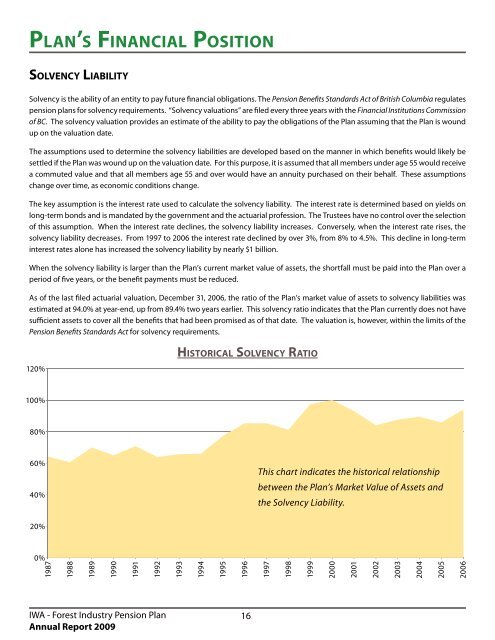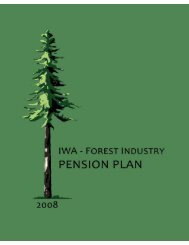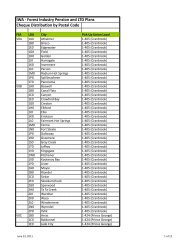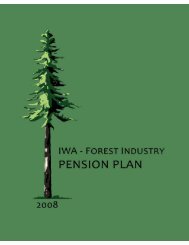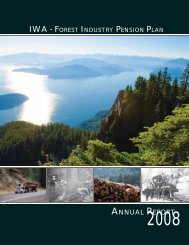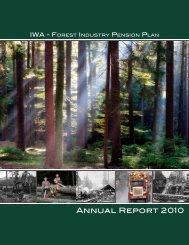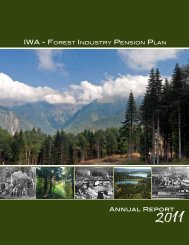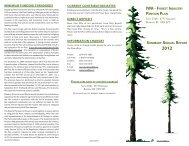2009 Annual Report - IWA Forest Industry Pension Plan
2009 Annual Report - IWA Forest Industry Pension Plan
2009 Annual Report - IWA Forest Industry Pension Plan
You also want an ePaper? Increase the reach of your titles
YUMPU automatically turns print PDFs into web optimized ePapers that Google loves.
Pl a n ’s Fi n a n c i a l Po s i t i o n<br />
So lv e n c y Liability<br />
Solvency is the ability of an entity to pay future financial obligations. The <strong>Pension</strong> Benefits Standards Act of British Columbia regulates<br />
pension plans for solvency requirements. “Solvency valuations” are filed every three years with the Financial Institutions Commission<br />
of BC. The solvency valuation provides an estimate of the ability to pay the obligations of the <strong>Plan</strong> assuming that the <strong>Plan</strong> is wound<br />
up on the valuation date.<br />
The assumptions used to determine the solvency liabilities are developed based on the manner in which benefits would likely be<br />
settled if the <strong>Plan</strong> was wound up on the valuation date. For this purpose, it is assumed that all members under age 55 would receive<br />
a commuted value and that all members age 55 and over would have an annuity purchased on their behalf. These assumptions<br />
change over time, as economic conditions change.<br />
The key assumption is the interest rate used to calculate the solvency liability. The interest rate is determined based on yields on<br />
long-term bonds and is mandated by the government and the actuarial profession. The Trustees have no control over the selection<br />
of this assumption. When the interest rate declines, the solvency liability increases. Conversely, when the interest rate rises, the<br />
solvency liability decreases. From 1997 to 2006 the interest rate declined by over 3%, from 8% to 4.5%. This decline in long-term<br />
interest rates alone has increased the solvency liability by nearly $1 billion.<br />
When the solvency liability is larger than the <strong>Plan</strong>’s current market value of assets, the shortfall must be paid into the <strong>Plan</strong> over a<br />
period of five years, or the benefit payments must be reduced.<br />
As of the last filed actuarial valuation, December 31, 2006, the ratio of the <strong>Plan</strong>’s market value of assets to solvency liabilities was<br />
estimated at 94.0% at year-end, up from 89.4% two years earlier. This solvency ratio indicates that the <strong>Plan</strong> currently does not have<br />
sufficient assets to cover all the benefits that had been promised as of that date. The valuation is, however, within the limits of the<br />
<strong>Pension</strong> Benefits Standards Act for solvency requirements.<br />
120%<br />
Hi s t o r i c a l So lv e n c y Ra t i o<br />
100%<br />
80%<br />
60%<br />
40%<br />
This chart indicates the historical relationship<br />
between the <strong>Plan</strong>’s Market Value of Assets and<br />
the Solvency Liability.<br />
20%<br />
0%<br />
1987<br />
1988<br />
1989<br />
1990<br />
1991<br />
1992<br />
1993<br />
1994<br />
1995<br />
1996<br />
1997<br />
1998<br />
1999<br />
2000<br />
2001<br />
2002<br />
2003<br />
2004<br />
2005<br />
2006<br />
<strong>IWA</strong> - <strong>Forest</strong> <strong>Industry</strong> <strong>Pension</strong> <strong>Plan</strong><br />
<strong>Annual</strong> <strong>Report</strong> <strong>2009</strong><br />
16


